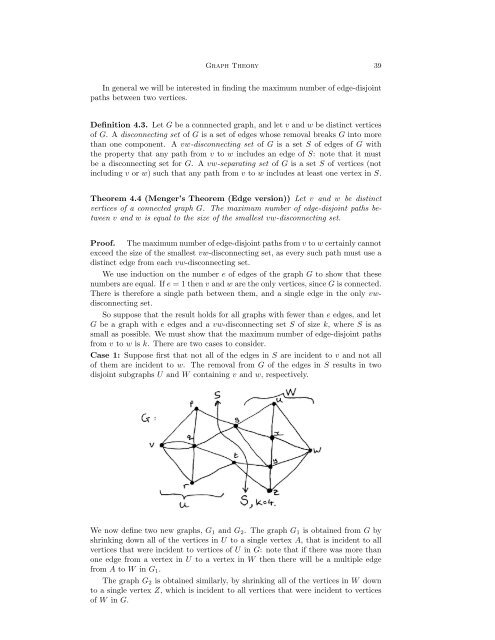You also want an ePaper? Increase the reach of your titles
YUMPU automatically turns print PDFs into web optimized ePapers that Google loves.
<strong>Graph</strong> <strong>Theory</strong> 39In general we will be interested in finding the maximum number of edge-disjointpaths between two vertices.Definition 4.3. Let G be a connnected graph, and let v and w be distinct verticesof G. A disconnecting set of G is a set of edges whose removal breaks G into morethan one component. A vw-disconnecting set of G is a set S of edges of G withthe property that any path from v to w includes an edge of S: note that it mustbe a disconnecting set for G. A vw-separating set of G is a set S of vertices (notincluding v or w) such that any path from v to w includes at least one vertex in S.Theorem 4.4 (Menger’s Theorem (Edge version)) Let v and w be distinctvertices of a connected graph G. The maximum number of edge-disjoint paths betweenv and w is equal to the size of the smallest vw-disconnecting set.Proof. The maximum number of edge-disjoint paths from v to w certainly cannotexceed the size of the smallest vw-disconnecting set, as every such path must use adistinct edge from each vw-disconnecting set.We use induction on the number e of edges of the graph G to show that thesenumbers are equal. If e = 1 then v and w are the only vertices, since G is connected.There is therefore a single path between them, and a single edge in the only vwdisconnectingset.So suppose that the result holds for all graphs with fewer than e edges, and letG be a graph with e edges and a vw-disconnecting set S of size k, where S is assmall as possible. We must show that the maximum number of edge-disjoint pathsfrom v to w is k. There are two cases to consider.Case 1: Suppose first that not all of the edges in S are incident to v and not allof them are incident to w. The removal from G of the edges in S results in twodisjoint subgraphs U and W containing v and w, respectively.We now define two new graphs, G 1 and G 2 . The graph G 1 is obtained from G byshrinking down all of the vertices in U to a single vertex A, that is incident to allvertices that were incident to vertices of U in G: note that if there was more thanone edge from a vertex in U to a vertex in W then there will be a multiple edgefrom A to W in G 1 .The graph G 2 is obtained similarly, by shrinking all of the vertices in W downto a single vertex Z, which is incident to all vertices that were incident to verticesof W in G.













